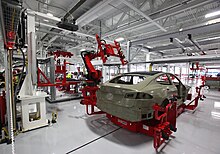This is an old revision of this page, as edited by Prokaryotes (talk | contribs) at 21:34, 24 January 2016 (→Actions: sort). The present address (URL) is a permanent link to this revision, which may differ significantly from the current revision.
Revision as of 21:34, 24 January 2016 by Prokaryotes (talk | contribs) (→Actions: sort)(diff) ← Previous revision | Latest revision (diff) | Newer revision → (diff)Climate action describes various affords to prevent what is considered dangerous climate change.
Actions

Carbon sinks
See also: Carbon sink § Enhancing natural sequestrationCarbon sinks can sequester carbon naturally or artificially. Reducing emissions from deforestation and forest degradation has the objective of mitigating climate change through reducing net emissions of greenhouse gases through enhanced forest management in developing countries.
Divestment
See also: Fossil-fuel phase-outFossil fuel divestment describes actions to withdraw investment assets including stocks, bonds, and investment funds from companies involved in extracting fossil fuels, in an attempt to reduce climate change emissions.
Financial experts, such as the Bank of England or Goldman Sachs, project that expensive fossil fuel projects will become worthless due to future climate actions. According to research, to limit the climate change to a 2°C target many fossil fuels have to be left in the ground.
Energy
See also: Energy subsidies See also: Efficient energy useRenewable energy generation has increased in recent years, i.e. with solar power, or wind power. For instance financial incentives for photovoltaics can encourage faster adoption.
Global agreements
- Effective since 2005 is the Kyoto Protocol, an international treaty, which extends the 1992 United Nations Framework Convention on Climate Change (UNFCCC) that commits State Parties to reduce greenhouse gases emissions.
- The 2015 United Nations Climate Change Conference resulted in a global agreement for the goal of limiting global warming to less than 2 degrees Celsius (°C) compared to pre-industrial levels. Nations will also "pursue efforts to" limit the temperature increase to 1.5 °C.
Negative emissions
See also: Carbon dioxide removalBio-energy with carbon capture and storage (BECCS) is a greenhouse gas mitigation technology which produces negative carbon dioxide emissions by combining bioenergy (energy from biomass) use with geologic carbon capture and storage. The IPCC Fifth Assessment Report noted, "Net negative emissions can be achieved when more GHGs are sequestered than are released into the atmosphere (e.g., by using bio-energy in combination with carbon dioxide capture and storage)."
Planning
See also: European Climate Change ProgrammeA Climate Action Plan (CAP) is a set of strategies or a framework intended to guide efforts for reducing greenhouse gas emissions.
Taxation
Climate actions can include the adoption of a carbon tax, as an incentive to reduce carbon emissions, and to adopt alternatives.
Transportation

The carbon footprint and other emissions of electric vehicles varies depending on the fuel and technology used for electricity generation.
According to Department of Energy, 84% of existing vehicles could be switched over to plug-in hybrids without requiring any new grid infrastructure. In terms of transportation, the net result would be a 27% total reduction in emissions of the greenhouse gases carbon dioxide, methane, and nitrous oxide, a 31% total reduction in nitrogen oxides, a slight reduction in nitrous oxide emissions, an increase in particulate matter emissions, the same sulfur dioxide emissions, and the near elimination of carbon monoxide and volatile organic compound emissions (a 98% decrease in carbon monoxide and a 93% decrease in volatile organic compounds). The emissions would be displaced away from street level, where they have "high human-health implications."
See also
References
- "Fossil fuel divestment: a brief history". www.theguardian.com/. The Guardian. Retrieved 25 March 2015.
- "Leave fossil fuels buried to prevent climate change, study urges". The Guardian. 2015.
- "The geographical distribution of fossil fuels unused when limiting global warming to 2 °C". Nature. 2015. doi:10.1038/nature14016.
{{cite journal}}: Unknown parameter|authors=ignored (help) - "Kyoto Protocol to the United Nations Framework Convention on Climate Change: Annex B". United Nations Framework Convention on Climate Change. n.d. Retrieved 8 October 2011.
- "Adoption of the Paris agreement—Proposal by the President—Draft decision -/CP.21". UNFCCC. 2015-12-12. Archived from the original (PDF) on 2015-12-12. Retrieved 2015-12-12.
{{cite web}}: Unknown parameter|deadurl=ignored (|url-status=suggested) (help) - Sutter, John D.; Berlinger, Joshua (12 December 2015). "Final draft of climate deal formally accepted in Paris". CNN. Cable News Network, Turner Broadcasting System, Inc. Retrieved 12 December 2015.
- Obersteiner, M. (2001). "Managing Climate Risk". Science. 294 (5543): 786–7. doi:10.1126/science.294.5543.786b. PMID 11681318.
- "Two degree climate target not possible without 'negative emissions', scientists warn". CarbonBrief. 2015.
- "Climate Action Planning" (PDF). NREL. Retrieved January 23, 2016.
- Gupta, S.; et al. (2007). "13.2.1.2 Taxes and charges". Policies, instruments, and co-operative arrangements. Climate Change 2007: Mitigation. Contribution of Working Group III to the Fourth Assessment Report of the Intergovernmental Panel on Climate Change (B. Metz et al. Eds.). Print version: Cambridge University Press, Cambridge, U.K., and New York, N.Y., U.S.A.. This version: IPCC website. Retrieved 2010-03-18.
- "Impacts assessment of plug-in hybrid vehicles on electric utilities and regional u.s. power grids" (PDF). Pacific Northwest National Laboratory. 2010.